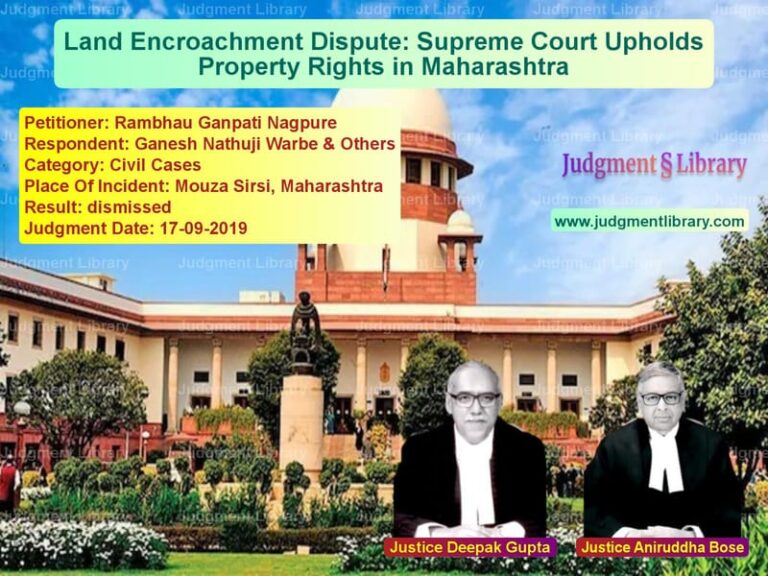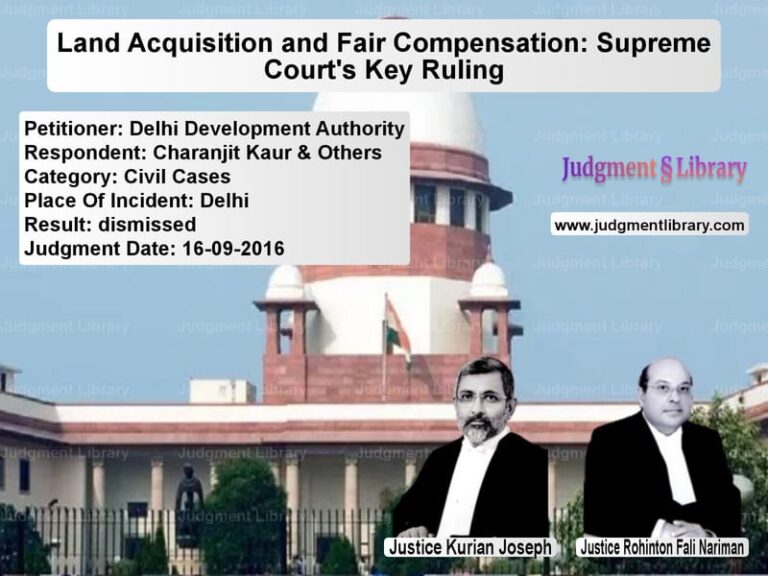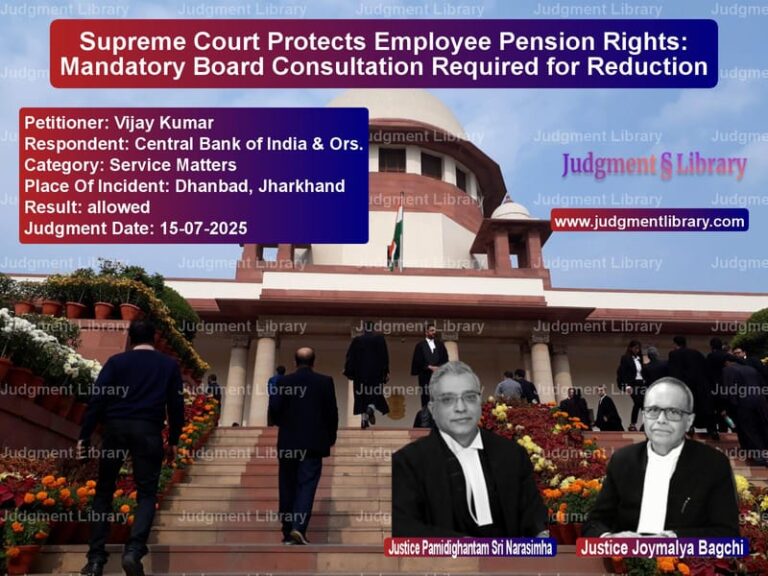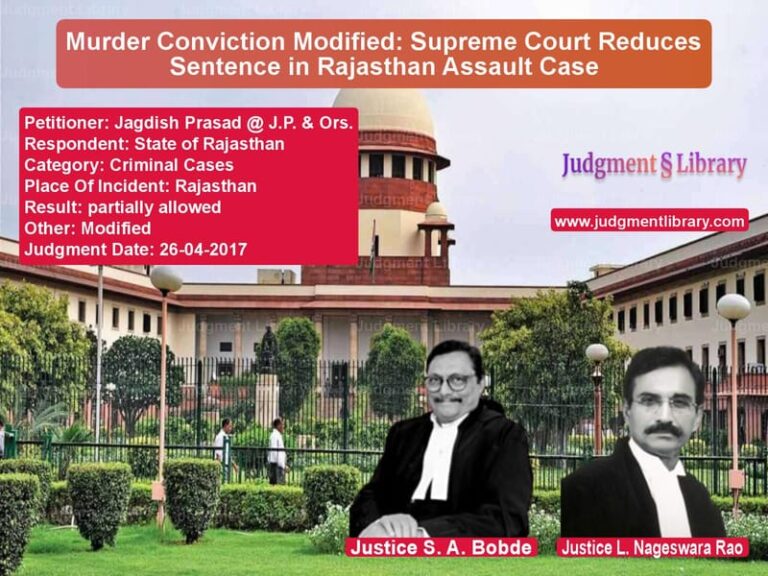Supreme Court Denies Land Restoration to Industrial Firm in Singur Case
In a significant ruling on October 13, 2025, the Supreme Court of India delivered a crucial judgment clarifying who can benefit from court-ordered land restoration when acquisition proceedings are quashed. The case, centered on the infamous Singur land acquisition in West Bengal’s Hooghly district, pitted the State Government against M/S Santi Ceramics Pvt. Ltd., an industrial company seeking to get back land that had been acquired nearly two decades earlier for the Tata Nano car project. The Court’s decision draws a clear line between vulnerable agricultural communities and commercial enterprises when it comes to extraordinary judicial remedies.
The Singur Land Acquisition Saga
The controversy traces back to 2006 when the West Bengal government acquired over 1000 acres of land in Singur for establishing Tata Motors’ manufacturing plant for the Nano car. The acquisition included agricultural lands owned by farmers as well as industrial plots, including 28 bighas belonging to Santi Ceramics, which had been operating a ceramic electrical insulators manufacturing unit on the site since 2003. The company had purchased the land in 2001-2002 and obtained permission to convert it from agricultural to industrial use. When the acquisition process began, Santi Ceramics filed objections, but these were rejected, and the company eventually accepted compensation of approximately INR 14.55 crore without protest in 2006.
The acquisition sparked massive protests from farmers and eventually reached the courts through public interest litigation. In 2016, the Supreme Court in the landmark Kedar Nath Yadav case quashed the entire acquisition process, citing procedural violations and the disproportionate impact on poor agricultural workers. The Court directed the state to restore the land to original landowners/cultivators within twelve weeks. It was only after this judgment that Santi Ceramics, which had remained silent for a decade, suddenly sought restoration of its land, claiming parity with the farmers who had fought the legal battle.
The Legal Battle Intensifies
When the West Bengal government refused to restore Santi Ceramics’ land, the company approached the Calcutta High Court, which ruled in its favor. The High Court held that the Supreme Court’s directions in Kedar Nath Yadav applied to all landowners without distinction between cultivators and business entities. The state government then appealed to the Supreme Court, arguing that the restoration remedy was specifically designed for vulnerable agricultural communities, not for industrial companies with substantial resources.
The appellants’ counsel Mr. Harin P Rawal and Mr. Ashok Kumar Panda, Learned Senior Counsel appearing for the Appellants, strenuously argued that the High Court committed a grave error in extending restoration to Respondent No.1. It was contended that this Court’s decision in Kedar Nath Yadav (supra) was designed with specific protective intent for vulnerable agricultural communities who lacked resources to challenge governmental action.
On the other side, the company’s representative Mr. Sridhar Potaraju, Learned Senior Counsel appearing on behalf of Respondent No.1, vehemently opposed the instant appeal by challenging the Appellants’ interpretation of Kedar Nath Yadav (supra). He asserted that the judgment contained no artificial distinction between different categories of landowners, with the terminology “landowners/cultivators” encompassing every person whose land was subjected to the procedurally flawed acquisition.
The Supreme Court’s Principled Analysis
The Supreme Court, comprising Justices Surya Kant and Joymaiya Bagchi, delivered a comprehensive judgment that went beyond the literal interpretation of the Kedar Nath Yadav decision to examine its underlying principles and intent. The Court emphasized that judicial remedies must be understood in their proper context, particularly when they involve extraordinary interventions like setting aside completed land acquisitions.
The Court carefully examined the original Kedar Nath Yadav judgment and noted that it was specifically concerned with protecting the most vulnerable segments of society. The Court quoted from the earlier judgment: “What, however, cannot be lost sight of is the fact that when the brunt of this ‘development’ is borne by the weakest sections of the society, more so, poor agricultural workers who have no means of raising a voice against the action of the mighty state government, as is the case in the instant fact situation, it is the onerous duty of the state Government to ensure that the mandatory procedure laid down under the L.A. Act and the Rules framed there under are followed scrupulously otherwise the acquisition proceedings will be rendered void ab initio in law.”
This identification of “poor agricultural workers” as the “weakest sections of society” was crucial to the Court’s reasoning. The Court explained that subsistence farmers facing potential destitution from loss of their sole livelihood needed extraordinary protection, which is why the restoration remedy was conceived. In contrast, Santi Ceramics was an established industrial concern operating a 60,000 square feet manufacturing facility employing over 100 workers since 2003. The company had financial resources and institutional access to challenge the acquisition through available legal channels but chose not to do so for a decade.
Procedural Principles and the Danger of Free-Riding
The Court also addressed important procedural principles that prevented Santi Ceramics from benefiting from litigation it didn’t participate in. The Court explained that when acquisition proceedings are quashed on grounds personal to specific objectors, the relief operates only for those parties who actively contested the matter. However, when the entire process is declared void from the beginning, the relief can potentially benefit all affected parties. But even in such cases, the Court noted, there are limitations.
The Court observed that Santi Ceramics represented a “classic free-rider problem” that judicial remedies cannot encourage. The company had accepted substantial compensation without protest, remained passive while cultivators pursued litigation for years, and only emerged as a claimant after favorable outcomes were secured by others. The Court warned that “Permitting industrial entities to claim restoration benefits from litigation they chose not to pursue would establish an undesirable precedent. Such an approach would incentivize strategic inaction, encouraging parties to remain dormant during protracted litigation only to emerge as claimants after favourable outcomes are secured by others.”
This approach, the Court reasoned, would undermine both the targeted nature of remedial relief and the fundamental principle that legal benefits flow from active pursuit of remedies, not passive opportunism.
Practical Considerations and Final Directions
The Court also considered practical realities—nearly two decades had passed since the acquisition, Tata Motors had abandoned the project in 2010, and the state government had already undertaken extensive survey operations to restore land to cultivators. The structures originally on Santi Ceramics’ land had been modified during these restoration efforts to enable demarcation and distribution to farmers. Under these circumstances, complete restoration had become practically impossible.
While allowing the state’s appeal and setting aside the High Court’s order for restoration, the Supreme Court provided alternative relief to Santi Ceramics. The company was permitted to remove any remaining structures, plant, and machinery from the land within three months, or alternatively, request a public auction of these assets with proceeds going to the company. The Court also directed that no recovery of excess compensation would be effected by the state government.
Broader Implications
This judgment establishes important principles about the targeted nature of judicial remedies, particularly in cases involving vulnerable communities. It clarifies that extraordinary remedies designed for disadvantaged sections cannot be automatically extended to commercial entities with resources to protect their interests. The decision also reinforces the principle that legal rights must be actively pursued rather than passively awaited, preventing what the Court termed “strategic inaction” where parties wait to see if others succeed before making their claims.
The ruling balances the need to protect vulnerable communities from state power while maintaining stability in land acquisition processes. It acknowledges that while procedural violations must be addressed, the remedies should be proportionate and targeted toward those who genuinely lack the means to protect their interests. For state governments undertaking development projects, the judgment provides clarity on the differentiated treatment of various categories of landowners when acquisition processes face legal challenges.
In the larger context of India’s development narrative, the Singur case represents the complex tension between industrial progress and agricultural livelihoods. The Supreme Court’s nuanced approach in this judgment recognizes that while development is necessary, it cannot come at the cost of trampling upon the rights of the most vulnerable, and that commercial entities with resources and capabilities must actively participate in legal processes rather than benefit from the struggles of others.
Petitioner Name: The State of West Bengal and Others.Respondent Name: M/S Santi Ceramics Pvt. Limited and Another.Judgment By: Justice Surya Kant, Justice Joymaiya Bagchi.Place Of Incident: Singur, Hooghly District, West Bengal.Judgment Date: 13-10-2025.Result: allowed.
Don’t miss out on the full details! Download the complete judgment in PDF format below and gain valuable insights instantly!
Download Judgment: the-state-of-west-be-vs-ms-santi-ceramics-p-supreme-court-of-india-judgment-dated-13-10-2025.pdf
Directly Download Judgment: Directly download this Judgment
See all petitions in Property Disputes
See all petitions in Compensation Disputes
See all petitions in Public Interest Litigation
See all petitions in Judgment by Surya Kant
See all petitions in Judgment by Joymalya Bagchi
See all petitions in allowed
See all petitions in Quashed
See all petitions in supreme court of India judgments October 2025
See all petitions in 2025 judgments
See all posts in Civil Cases Category
See all allowed petitions in Civil Cases Category
See all Dismissed petitions in Civil Cases Category
See all partially allowed petitions in Civil Cases Category







